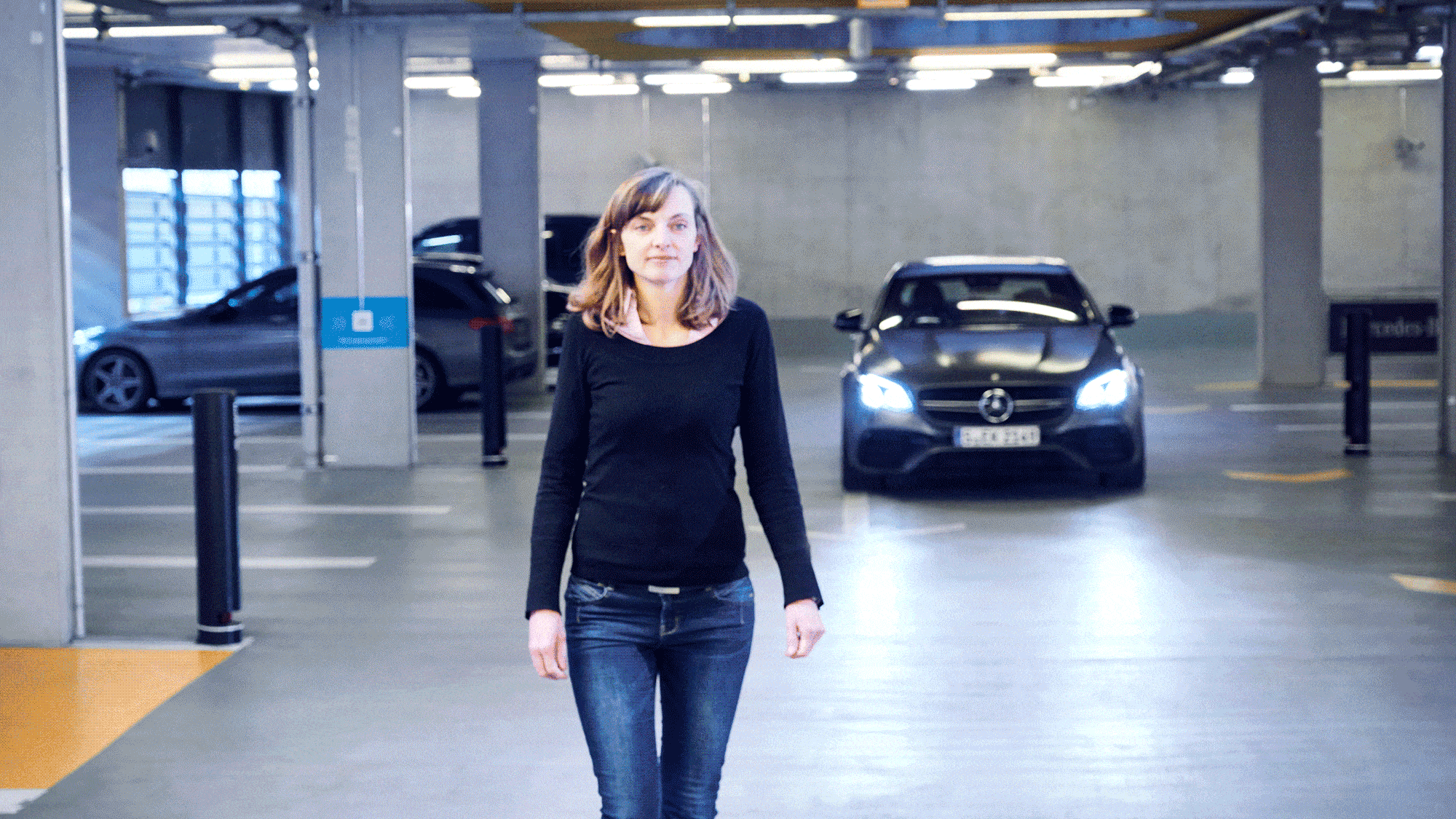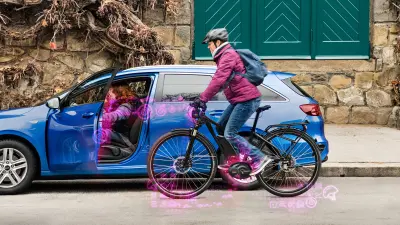A smarter way of parking

A vehicle maneuvers across the parking garage as if steered by remote control. Nobody is sitting at the wheel. Driverless cars are sure to become a common sight once automated valet parking makes inroads. Smart parking technology paired with a smartphone app will soon guide cars to vacant spaces. The Bosch associate Sabine Sayler explains how the smart parking system works.
Drop off and walk away
Cars that can look for somewhere to park on their own? Most of the technology needed for this is already standard in many of today’s cars. Such features include automatic transmission, ESP, an electric parking-brake system, power steering, a communication unit, and a remote-controllable start-stop function. A sedan equipped with these features is waiting for Sabine Sayler in the parking garage of the Mercedes-Benz Museum in Stuttgart. She is well acquainted with both the vehicle and the garage, which has been her workplace for some time now.
Two years ago, she joined the team tasked with developing automated valet parking as a product owner. Pulling her car up to the drop-off area, she climbs out and reaches for her cell phone. “Circling the far corners of a parking garage, struggling to find an available parking space, and squeezing into a tight spot — now you can forget all that.” And with that, Sayler launches the app and coolly walks away. As she heads for the exit, her car sets out on its own to take care of the rest.

Safety first in the parking garage of the future
The sedan manages to navigate this enclosed space without the help of a driver behind the wheel. The parking garage’s smart infrastructure knows every corner, identifies any obstacles, and tells the car when to drive and when to stop. It does so on the basis of lidar sensors, which use a laser beam to scan a wide horizontal area. An echo alerts the system to a potential obstacle. Distance is calculated on the basis of the time lapse between transmission of a pulse and reception of an echo. Lidar sensors are installed at regular intervals in 30-centimeter and 80-centimeter high posts. These posts mark the drive aisle with a color-coded guidance system. Their LEDs light up red to indicate a problem. If they light up blue, their sensors have detected the vehicle. If they light up green, the aisle is good to go and the vehicle is cleared to proceed. The system is as fail-safe as it is simple, and features several safeguards. Monitoring software constantly keeps an eye on the software piloting the car to catch any glitches. This monitoring software, in turn, is double-checked by another piece of software to add one more layer of safety. Two independent servers transmit the sensor data. Only when both arrive at the same result will a driving command be issued. The lidar sensors scan the area around the vehicle 25 times a second. Several times a second, driving commands are recalculated and double-checked. Reacting faster than any human could, the vehicle stops in an instant if the system detects a fault or an obstacle.

Several times a second,
driving commands are recalculated and double-checked.
Smart parking is ready to go

The vehicle drives up the ramp to the next level, but suddenly comes to a standstill even before the upper deck is in full view. As yet unseen, a toy bunny lying in the drive aisle has been detected by the sensors in the posts. They relay this information, halting the car in its tracks. A human driver could not have spotted the toy rabbit from that vantage point. “When we developed automated valet parking, we had to take all eventualities into account and consider everything that could possibly go wrong,” Sabine Sayler says. This is why the security package includes blanket video surveillance of the garage. The autonomous vehicles are under constant observation, with the video cameras’ recordings serving as eyewitnesses in the event of an accident. This combination of smart parking technology was enough the satisfy the authorities responsible for issuing operating permits.
This was a true first — the first ever fully automated, driverless parking function to receive such a permit. In the future, drivers will no longer have to waste time looking for a parking space, and there will be no more walking through frequently inhospitable parking garages. And as car doors will no longer have to be opened to let occupants in and out, cars can be parked closer together, allowing parking garage operators to squeeze up to 20 percent more vehicles into the available space. By the end of 2022, some three dozen parking garages around the world are to be equipped with this smart parking technology, and this figure is expected to be several thousand by the end of 2025. In the near future, smart camera technology will take over from the lidar sensors. Work to make this possible is already underway.
Keep your distance
One of the great advantages of automated valet parking is that it also works in situations where human drivers are in the mix. Driver-controlled and driverless vehicles stay out of each others’ way in the parking garage. Traffic flows smoothly and without congestion. But this also means that the sensors have to detect not only walls, pillars, and vehicles, but adults and children as well. These requirements are derived from risk analysis and were defined in collaboration with the testing agency and the authorities. To ensure everyone’s safety, the autonomous vehicle automatically comes to a standstill whenever a moving object comes within a four-meter radius. It resumes its journey only when the obstacle moves back out of that range. The backscatter signals work with such great precision that the sensors detect even relatively small obstacles in the vehicle’s path and bring it to a stop every time.

A wink from the blinkers

The car is within sight of its destination. It rolls past the available parking stall, stops, and backs into the parking slot in one smooth motion. The autonomous journey has reached its end. With a kind of affirmative wink, the vehicle’s blinkers briefly light up. And as Sayler demonstrates at the drop-off point of the smart parking system, retrieving the car is an exercise in convenience. She launches the mobile app once more, and the car heeds her call, returning on its own.


